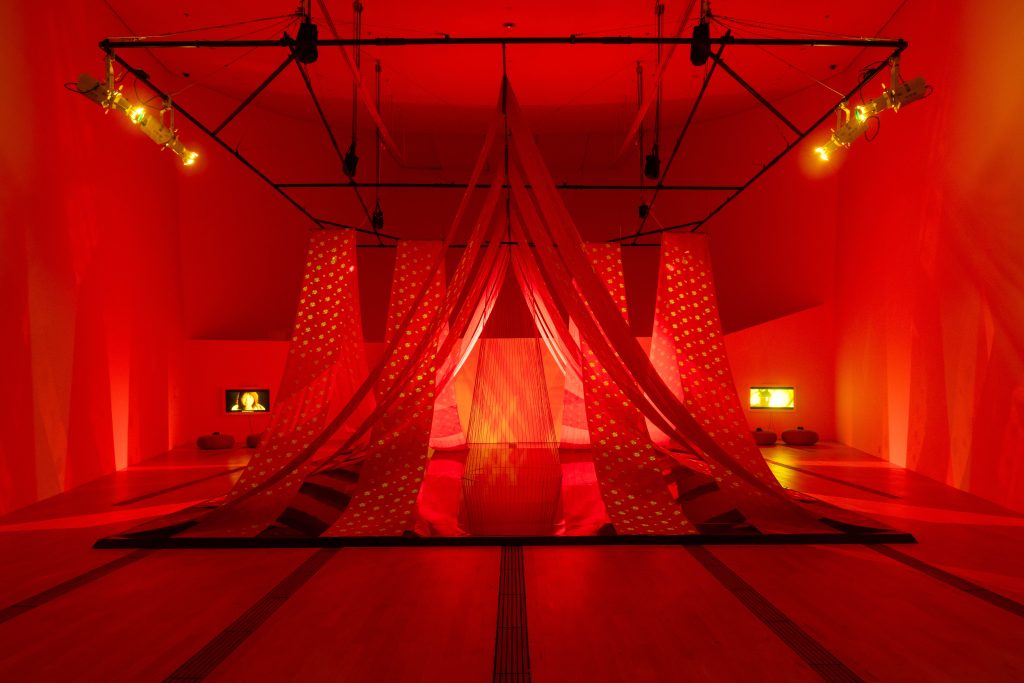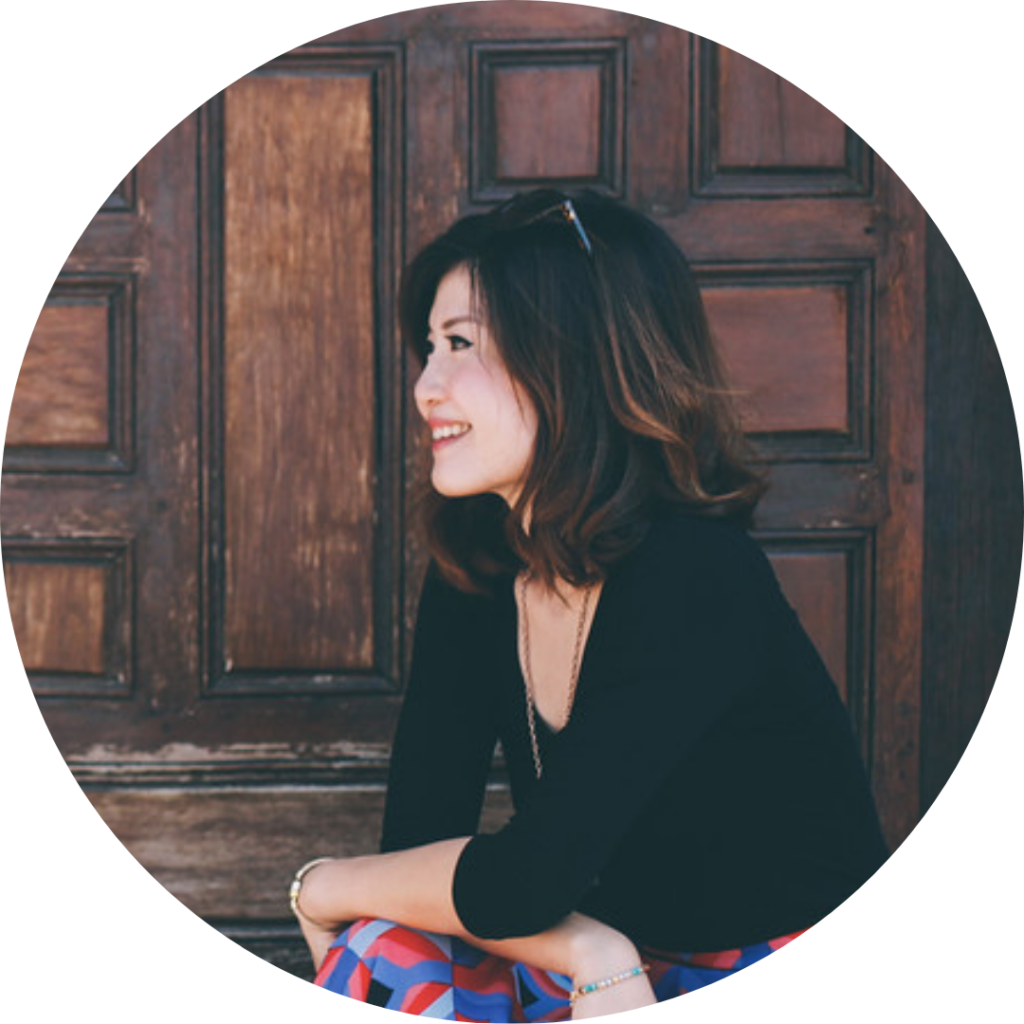A Conversation With New Eden’s Curatorial Team
Coinciding with ART SG 2024, ArtScience Museum presents New Eden: Science Fiction Mythologies Transformed, showcasing the work of twenty-four Asian women artists and collectives, to offer fresh insights on a genre premised on envisioning alternative futures and imaginary realms. ART SG speaks to the exhibition’s curatorial team about the exhibition and the Museum’s upcoming season of science fiction.
Share this article:
Interview by Tan Siuli

Sputniko! and Napp Studio & Architects, Red Silk of Fate – The Shrine, 2023
Image courtesy ArtScience Museum
New Eden features an all-women artist line-up, exploring how science fiction is approached through the perspective of Asia and the work of women. Rarely do we encounter such a constellation of voices and positions, as science fiction has conventionally been dominated by men. In your view, what are the new or different perspectives and narratives that women artists working in Asia bring to this genre?
Honor Harger, Vice President of ArtScience Museum & Attractions, Marina Bay Sands: New Eden shows how contemporary art can forge connections between seemingly disparate realms, science fiction and Eastern spiritual belief systems. This exhibition contains narratives that are more nuanced, with a particular emphasis on kindness, empathy, embracing the unknown and confronting stereotypical biasness in the science fiction genre.
The women artists and collectives from Asia challenge our preconceived notions about what we usually see in the science fiction genre – the stereotypical portrayal of aliens, climate apocalypse and colonization of other planets are some examples. Instead, this exhibition offers a unique perspective that explores the intricate relationship between humanity and the natural environment, envisioning scenarios in which technology and nature seamlessly intertwine.
For instance, in the work by The House of Natural Fiber, which ArtScience Museum commissioned, we encounter the Hindu-Javanese goddess, Lakshmi or Dewi Seri. The artists suggest she may be the reason for nature’s regenerative prowess. Meanwhile, the work of Moon and Jeon fuses Western science fiction aesthetics and Taoist philosophy, including the idea of “warping” or “folding” space, suggesting that through spiritual cultivation, individuals can manipulate the very fabric of reality itself, altering distances and connections between entities.

Moon and Jeon, The Ways of Folding Space and Flying, 2015
Image courtesy the artists
Another new perspective can be seen in the work of Club Ate, Etsuko Ichihara and Morehshin Allahyari, who transform mythological stories involving female astral spirits and creatures into forms of future folklore, dispelling the negative connotations often seen in traditional folk stories.
Towards the end of the exhibition, the seminal work of Mariko Mori, “Miko No Inori” is a piece that materialises the intersection of Eastern spiritual tradition and science fiction aesthetics. Mori adopts a persona of a futuristic Shinto priestess performing a ritual beckoning the viewer to travel between worlds. She becomes a conduit between our earthly existence and a spiritual cosmos, seamlessly fusing elements of contemporary technology and ancient transcendental practices.
These different perspectives of Asian women artists and collectives invite more gentle considerations about how we see the world, and bridge the gap between science and spirituality.

Mariko Mori, Miko No Inori, 1996
Image courtesy the artist
What sparked the idea for this exhibition, and how did it evolve along the curatorial process? Were there any artists or collectives who challenged some of your pre-existing assumptions?
Adrian George, Director, Programmes, Exhibitions & Museum Services: New Eden started out as an idea that Honor Harger had for an exhibition focused on women artists from Asia Pacific who drew inspiration from science fiction. Separately, Gail Chin, one of our exhibition producers, and Joel Chin, who manages art handling at the museum, came up with an idea for an exhibition on Asian science fiction. As such, we merged these ideas to create one new show curated by all four of us.
We were interested in the fact that the contemporary art world has had a fascination with science fiction in recent times, with many shows on the topic being presented in museums around the world. But rarely is science fiction approached from the perspective of Asia and through the work of women, so we wanted to approach the exhibition from that perspective.
The team took more than two years to look deeply into science fiction as a genre that aims to push boundaries and suggest new ways of looking at contemporary issues and ethical dilemmas. The pandemic and global lockdown around the world is also a real-life testament that we are truly living in a science fiction world, so the show felt topical to us.
Etsuko Ichihara, Namahage in Tokyo, 2017
Image courtesy Etsuko Ichihara and ISID OPEN INNOVATION LAB
Gail Chin, Exhibition Producer: During the course of putting New Eden together, the speculation of alternative worlds, and the “what ifs” that science fiction poses was one of the main inspirations for our curatorial work. The artists and collectives challenge assumptions in many different ways, offering alternative ways of looking at the future whether from the perspective of looking at ancient mythologies through a futuristic lens or critiques of the representation of Asian culture in Western science fiction films. The works in this exhibition show how artists in Asia are reclaiming agency and reshaping science fiction on its own terms.

Astria Suparak, Virtually Asian, 2021
Image courtesy the artist
Why are these works and voices important for our consideration, in this era?
Gail Chin: The 24 artists in New Eden engage with global themes that have made them influential figures in the art world. Artists such as Patty Chang and Cao Fei are known for their thought-provoking social commentary, using art to examine gender, urbanisation, and technology’s impact on society. Sputniko!, Anne Samat and Soe Yu Nwe interweave indigenous Asian motifs with contemporary sensibilities, a gesture that destabilises established art narratives and invites a more pluralistic engagement. It is also important to note that our ambition, in focusing on women artists and collectives was to confront the historical and mostly Western masculine bias of science fiction reconfiguring those narratives, embracing more egalitarian forms of storytelling and art-making. Science fiction operates as a speculative canvas, allowing us to project all sorts of possible futures and new ideas, that despite the fantasy scenarios could have real social resonance.
Anne Samat, Cannot Be Broken and Won’t Live Unspoken, 2022
Image courtesy ArtScience Museum
What, for you, are some of the most exciting takeaways from this exhibition, that could possibly be the seed for future projects?
Joel Chin, Supervisor Art Handling and Logistics: The first gallery of the exhibition presents visitors with a timeline of literary and cinematic science fiction. As we were developing that it became clear that at moments in history when the world was in conflict, or at risk, people began to engage more deeply in ideas of a utopian future, a future elsewhere and in alternate realities – the ultimate form of escapism. The world is in that place again now, with a concatenation of events: we are only just post-pandemic, we are in the midst of a rapidly accelerating climate crisis, there is an increasing risk of global recession and countries are at war. So it’s no surprise there is a resurgence in interest in science fiction and dreams of different futures. And yet the exhibition presents us with visions of a more empathetic, kinder world which suggests more hopeful futures may be possible. This is an important message to share with audiences at a time like this.

Lee Bul, Untitled, 2003
Image courtesy ArtScience Museum
Honor Harger: The deliberate choice to juxtapose aspects of Southeast Asia’s syncretic history with contemporary artworks is one of the key aspects of the exhibition for us. Positioning several ancient artefacts, generously loaned to us by Asian Civilisation Museum, alongside contemporary installations offered an interesting opportunity for us, not only to engage with the curatorial expertise at ACM, but to present these pieces to our very diverse audiences. This isn’t the first time we have collaborated with ACM. We also worked with them on our Universe and Art exhibition in 2017, and we are partnering with them again on our next exhibition, Mars: The Red Mirror. Having institutions work together in this way allows for interesting new forms of exhibition-making.

‘Words and Worlds’ Gallery in New Eden
Image courtesy ArtScience Museum
What can we look forward to in ArtScience Museum’s 2024 programming?
Adrian George: New Eden launches a season at ArtScience Museum that explores science fiction. The season continues with the opening of Mars: The Red Mirror on 25 November, and both exhibitions will run into 2024.
Anchoring the science fiction season is a major film programme, curated by Jerome Chee and Rachel Wong entitled In Search of Tomorrow. Running throughout the remainder of 2023 and in to 2024, it features over 25 contemporary and historical science fiction films that depict fantasies of what life could be like, on Earth or elsewhere. Featuring spaceships, androids, floating cities and red dusty planets, the film season takes an expansive dive into the kaleidoscopic tapestry of sci-fi on screen. It includes innovative science fiction from Asia like Krabi, 2562 (2019) by Anocha Suwichakornpong and Ben Rivers, Manta Ray (2018) by Phuttiphong Aroonpheng, Tetsuo: The Iron Man (1989) by Shinya Tsukamoto, Memoria (2021) by Apichatpong Weerasethakul and Unidentified (2022) by Jude Chun. We will also be screening classics of the genre like Solaris and Stalker by Andrei Tarkovsky, Interstellar (2014) by Christopher Nolan and 2001: A Space Odyssey (1968) by Stanley Kubrick, as well as cutting-edge new titles like Piaffe (2022) by Ann Oren and Creature (2022) by Asif Kapadia, which is having its Singapore premiere.
Alongside these films, we are showing the beautiful science-fiction virtual reality experience, Samsara by Taiwanese artist, Hsin-Chien Huang, in our VR Gallery.
There’s much more to come in 2024 but this will be a strong focus for us at the beginning of the year.
Explore New Eden: Science Fiction Mythologies Transformed at ArtScience Museum, available until March 3, 2024.
ABOUT THE AUTHOR: TAN SIULI
Tan Siuli is an independent curator with over a decade of experience encompassing the research, presentation and commissioning of contemporary art from Southeast Asia. Major exhibition projects include two editions of the Singapore Biennale (2013 and 2016), inter-institutional traveling exhibitions, as well as mentoring and commissioning platforms such as the President’s Young Talents exhibition series. She has also lectured on Museum-based learning and Southeast Asian art history at institutes of higher learning in Singapore. Her recent speaking engagements include presentations on Southeast Asian contemporary art at Frieze Academy London and Bloomberg’s Brilliant Ideas series.

Share this article:

